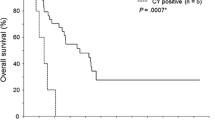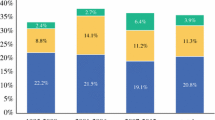Abstract
Background: The prevalence and significance of free cancer cells in the peritoneal cavity of clinically M0 gastric cancer patients is unknown. We reviewed our results with peritoneal washings to determine (1) the prevalence of positive cytology in M0 and M1 disease and (2) the influence of positive cytology on the pattern of failure and survival.
Methods: Laparoscopic washings were obtained from 127 patients with gastric cancer at Memorial Sloan-Kettering Cancer Center from December 1, 1990 to August 1, 1996. Cytology was performed by the Papanicolau technique.
Results: The prevalence of positive cytology was as follows: 0% (0/45) in T1/T2 M0 disease; 10% (3/31) in T3/T4 M0 disease; and 59% in M1 disease. The three M0 patients with positive cytology recurred intra-abdominally (median follow up of 8.5 months). Survival was significantly less compared with stage-matched controls with negative cytology resected for cure (P<.03), and the same as those patients with stage IV disease.
Conclusion: Patients with positive lavage cytology are stage IV, even in the absence of macroscopic peritoneal disease. Laparoscopic lavage cytology is a rapid technique for identifying the subset of M0 patients who are unlikely to benefit from resection alone. Such patients require additional treatment strategies to improve survival.
Similar content being viewed by others
References
Landry J, Tepper JE, Wood WC, Moulton EO, Koerner F, Sullinger J. Patterns of failure following curative resection of gastric carcinoma.Intl J Radiat Oncol Biol Phys 1990;19:1357–62.
Moore GE, Sako K, Kondo T, Badillo J, Burke E. Assessment of the exfoliation of tumor cells into body cavities.Surg Gynecol Obstet 1961;112:469–74.
Iitsuka Y, Kaneshima S, Tanida O, Takeuchi T, Koga S. Intraperitoneal free cancer cells and their viability in gastric cancer.Cancer 1979;44:1476–80.
Tanida O, Kaneshima S, Iitsuka Y, Kuda H, Kiyasu Y, Koga S. Viability of intraperitoneal free cancer cells in patients with gastric cancer.Acta Cytologica 1982;26:681–7.
Kaibara N, Iitsuka Y, Kimura A, et al. Relationship between area of serosal invasion and prognosis in patients with gastric carcinoma.Cancer 1987;60:136–9.
Griner PF, Mayewski RJ, Mushlin AI, Greenland P. Selection and interpretation of diagnostic tests and procedures. Principles and applications.Ann Intern Med 1981;94:557–92.
Burke EC, Karpeh MS, Conlon KC, Brennan MF. Laparoscopy in the management of gastric adenocarcinoma.Ann Surg 1997;225:262–7.
Lowy AM, Mansfield PF, Leach SD, Ajani J. Laparoscopic staging for gastric cancer.Surgery 1996;119:611–4.
Bonenkamp JJ, Songun I, Hermans J, van de Velde CJ. Prognostic value of positive cytology findings from abdominal washings in patients with gastric cancer.Br J Surg 1996;83:672–4.
Nakajima T, Harashima S, Hirata M, Kajitani T. Prognostic and therapeutic values of peritoneal cytology in gastric cancer.Acta Cytologica 1978;22:225–9.
Nekarda H, Schenck U, Ludwig C, et al. Prognostic impact of diagnostic lavage in completely resected gastric cancer [abstract].Gastric Cancer Congress Abstract Proceedings 1995;99.
Asao T, Fukuda T, Yazawa S, Nagamachi Y. Carcinoembryonic antigen levels in peritoneal washings can predict peritoneal recurrence after curative resection of gastric cancer.Cancer 1991;68:44–7.
Nishiyama M, Takashima I, Tanaka T, et al. Carcinoembryonic antigen levels in the peritoneal cavity: useful guide to peritoneal recurrence and prognosis for gastric cancer.W J Surg 1995;19:133–7.
Abe S, Yoshimura H, Tabara H, et al. Curative resection of gastric cancer: limitation of peritoneal lavage cytology in predicting the outcome.J Surg Oncol 1995;59:226–9.
Ueki K, Suzuki T, Aizawa K, et al. Peritoneal washing cytology of gastric cancer at three peritoneal cavities [abstract].Gastric Cancer Congress Abstract Proceedings 1995.
Terata N, Mizutani K, Shibata J, Kodama M, Okabe H. Evaluation of peritoneal lavage cytology at the time of operation for gastric cancer [abstract].Gastric Cancer Congress Abstract Proceedings 1995.
Author information
Authors and Affiliations
Rights and permissions
About this article
Cite this article
Burke, E.C., Karpeh, M.S., Conlon, K.C. et al. Peritoneal lavage cytology in gastric cancer: An independent predictor of outcome. Annals of Surgical Oncology 5, 411–415 (1998). https://doi.org/10.1007/BF02303859
Received:
Accepted:
Issue Date:
DOI: https://doi.org/10.1007/BF02303859




